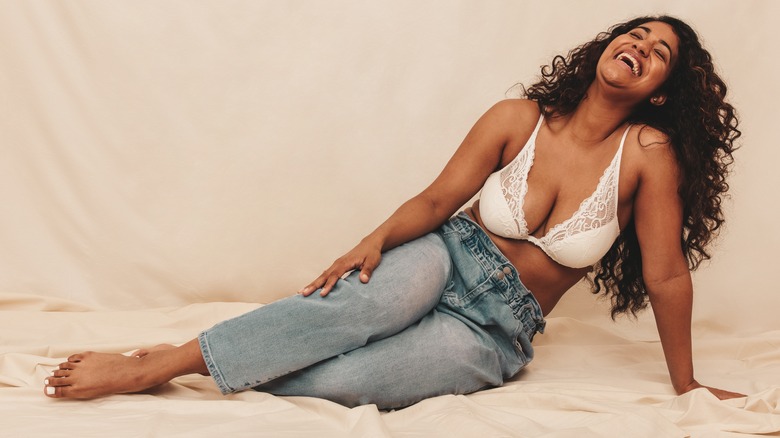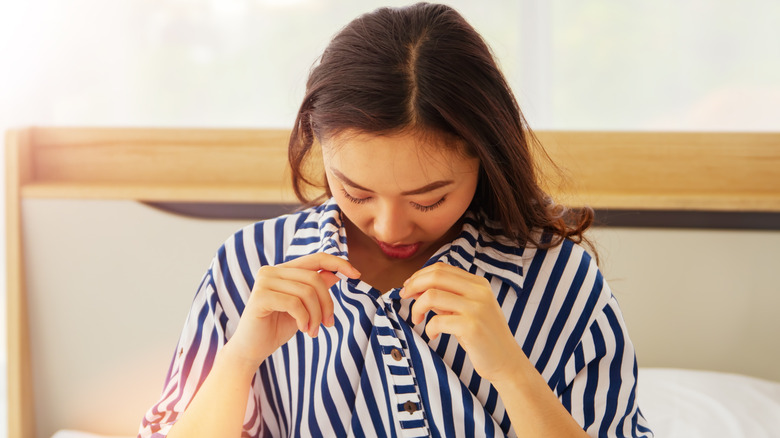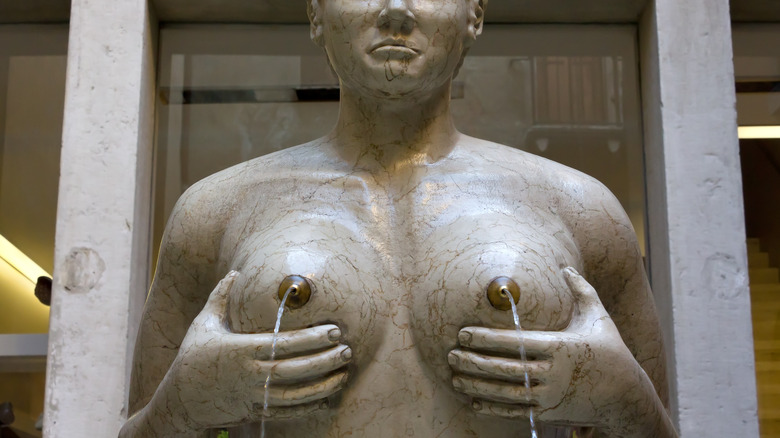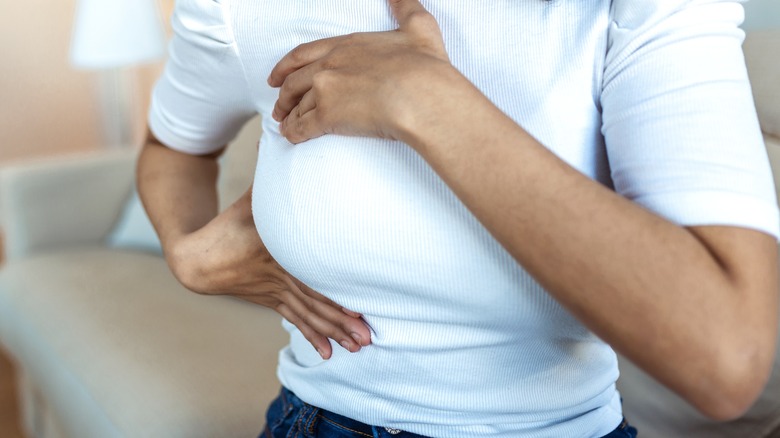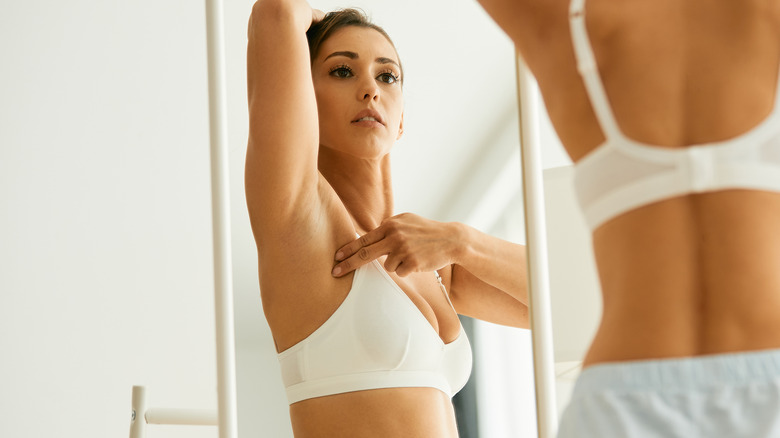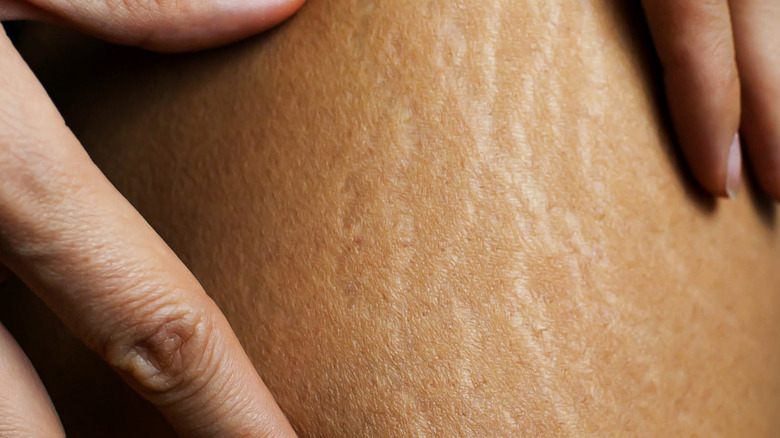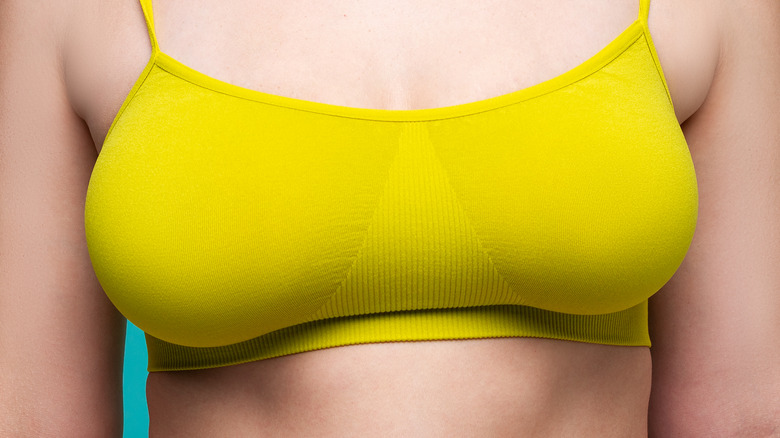Is This Normal? Your Breast Questions Answered
When it comes to breasts, no two are the same. But while many of us know that, it still doesn't stop some from wondering if their breasts are normal or not. From size, to shape, to nipple color and the details in between, we've all stood in the mirror, stared at our breasts, and wondered for a moment if what we see in the reflection is "normal." Well, unless your breasts have a bamboo tree growing out of them, it's safe to assume they're normal.
Although there are what's called "standard" breasts in regard to shape, the one that bra-makers refer to when creating lingerie — which would explain why there are benefits to going braless — everything else about breasts can be all over the map. While this is the case, a 2020 survey found that of the 18,541 people with breasts from 40 different countries who were interviewed, over 70% were dissatisfied with their breasts, with 48% wanting bigger breasts and 23% wishing for smaller breasts.
The study concluded that such a lack of satisfaction could have devastating health implications. Not only does it contribute to mental health issues, like lower self-esteem, but those who don't like their breasts are less likely to pay attention to them, as in they're probably skipping breast self-exams. You don't have to love your breasts, nor do you have to even like them. However, you should accept them and do your best to appreciate them. All breasts are perfect in their own way, including yours. So, if you're wondering if your perfect breasts are also normal, here's the proof they are.
Nipple hair
Fun fact: most of us will have at least one or two nipple hairs pop up at some point in our lives. These hairs have a lot to do with hormones, as well as genes. But while some people will have random hairs that will show up, others have hairy nipples all the time. Sometimes these hairs might be light and barely noticeable, while others can be dark and coarse.
"Yes, it is normal to have nipple hair," Babylon Health's GP Dr. Claudia Pastides told Cosmopolitan. "We don't know what percentage of women have nipple hair, but I suspect it is rather high ... Hair growth is complex and not solely down to testosterone. The female sex hormones also play a part and can lead to an increase in the amount of hair."
Although nipple hair is completely normal and harmless, if you're not into those hairs, you can remove them. But it's important to realize that even if you can't see any nipple hairs on your friends or topless people in movies and magazines, it doesn't mean they're not there. So maybe keeping yours around isn't such a bad idea.
Discharge
Even if you're not pregnant or nursing, nipple discharge is quite common. It's so prevalent, in fact, a 2017 study published in Radiologia Brasileira revealed that it's the third most complained-about part of having breasts, after pain and lumps, respectively. In most cases, the reason for discharge can be attributed to benign (non-cancerous) lesions in the breasts: ductal ectasia and papilloma. It's because these lesions reside in the milk ducts of the breasts that they cause this harmless discharge.
But while it's common, it doesn't mean you have to like it — similar to nipple hair. If the occasional nipple discharge annoys you, you can seek treatment. In some situations, it might just be the need to keep the nipple clean, while in other cases, a doctor may prescribe an antibiotic and suggest a warm compress. If the discharge is getting out of control, a doctor may want to remove the ducts that are causing the problem, but it's pretty rare that it will ever come to that (via Johns Hopkins).
Change in size
As you've probably already noticed, the breasts you had when you first hit puberty aren't the same size as the ones you have now. Although that's certainly a given, there are other reasons that can contribute to fluctuating breast size. Of course, weight gain and weight loss play a role, but so do hormones. For example, if you're someone who ovulates and menstruates, breasts usually increase in size — this is called clinical breast swelling. This is due to the increased levels of estrogen and progesterone at that time of the month, the first one causes the swelling of the milk ducts while the latter causes the connective tissue to swell, overall creating larger breasts until menstruation kicks in and they start to decrease in size again.
Your breasts also increase in size when you're aroused — yes! "Any sort of arousal will pump blood to the boobs, which can make them look fuller and larger — and, yes, this includes masturbation — but the effect is only fleeting and temporary, and results may vary in terms of size," women's health expert and nutritionist Hayley Ellis told Popsugar. "Don't expect too much of a change! Once you've cooled down, so will your boobs." It's also worth noting that in the heat of the moment, you nor your partner are likely to notice the increase in size.
Bumps and lumps
Just like how some people have smooth skin around their nipples and smooth tissue in their breasts, others can have lumps and bumps — again, totally normal. The bumps in and around the areola are called Montgomery glands which exist to help facilitate the milk secretion process. Even if you don't plan on having kids or nursing them, thanks to your hormonal makeup, your body is going to make sure you have these glands anyway.
According to the City of Hope Cancer Center, breast lumps are natural and normal, although some breasts may be lumpier than others. These lumps are, more often than not, due to cysts or fibroadenoma (a benign tumor) which are completely unrelated to cancer and just how the breast tissue is connected under the skin. It's also common for both of these things to change in size. Although they're harmless, a doctor may suggest you remove a benign tumor that has gotten bigger. Not because it can lead to cancer or any sort of issues, but because it may be uncomfortable.
Stretch marks
One of the most common places on the body for stretch marks is on the breasts — although you've probably noticed them on your hips, butt, and abdomen too. Stretch marks basically come with being alive — your body is growing, you're experiencing weight changes, and of course with time breasts can grow or start to sag, which can also contribute to stretch marks.
"During periods of rapid growth or stretching, the inner layer of skin (the dermis) may not be able to produce collagen and elastin as quickly as our skin is stretched, resulting in very small tears," plastic surgeon Emily Kirby told HuffPost. "These tears eventually heal into the linear and indented scars we know as stretch marks."
Both normal and harmless, these pink, purple, or skin-tone marks may fade in time or never at all. If you're not a fan of yours, you can take steps to lessen their visibility, but any type of treatment isn't likely to totally eliminate them. Retinol is effective to a degree, as is laser therapy. But it's important to realize these remedies, especially laser therapy, may prove to be a waste of money. Stretch marks are scars, so like any scar, you may as well wait for them to fade or accept them. Considering 50% to 90% of AFAB people have stretch marks, according to WebMD, not only are they super common, but they're not a big deal at all.
Asymmetrical breasts
If you're someone with uneven breasts, then you're in the majority. While some asymmetric breasts are quite noticeable, meaning there's a difference in size by a cup or two, others are only noticeable to the person who has them, and either case is normal. Considering the human body is bilaterally symmetrical, which means both sides are similar, but not exact matches of each other, you can't expect your boobs to be replicas.
"It is actually more common for women to have different breast shape and size than absolutely symmetrical breasts," Nazanin Khakpour, M.D., F.A.C.S., surgical oncologist specializing in breast cancer at Moffitt Cancer Center, told SELF. "They are sisters, not twins."
For the most part, uneven breasts can be attributed to genetics, but sometimes weight changes can also affect unevenness. As you start to lose or gain weight, one breast might change quicker, leaving the other to play catch-up in size. Sometimes there's a catch-up, other times there isn't — and that's totally normal.
Breast pain
According to the Cleveland Clinic, 70% of people with breasts will experience breast pain at least once in their life, with the majority of those cases happening between ages 30 and 50. Also known as mastalgia, the two major types of this pain are cyclic and noncyclic, which basically means menstrual-related or non-menstrual-related. The latter can be the result of pregnancy, birth control pills, as well as other medications including antidepressants and those that treat infertility, cysts or fibroadenomas, or having large breasts. But that's not all. Noncyclic breast pain can also be caused by activities such as smoking, drinking coffee, stress, and breastfeeding. No wonder breast pain is so common and so normal! There are also varying types of pain from a deep dull pain to pain that feels more stabbing in nature.
Takeaway? As much as having breasts can be awesome, they do come with a lot of side effects, most of which are totally normal. However, if you're worried about something you see or feel because it just doesn't seem right, call your doctor. When you tell them what's going on, they'll either assure you to not worry about it or suggest you come in just to make sure all is well.
